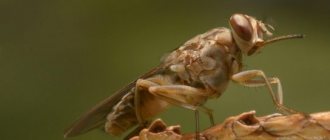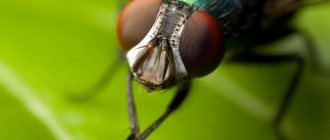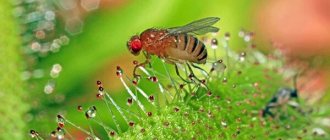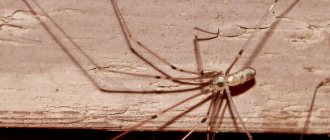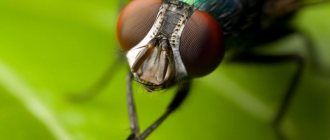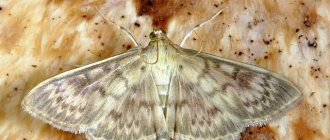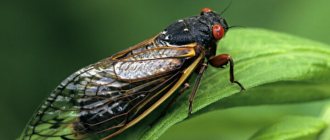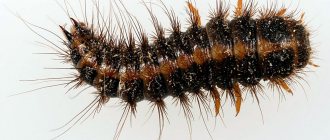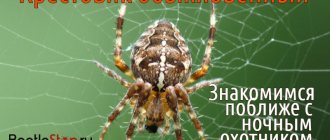The tsetse fly is a dangerous insect for humans. Because of its bites, about 50 thousand people die every year in African countries! Because of it, people are afraid to develop agricultural areas located near its habitat. To complicate the situation, the tsetse fly has a fairly long lifespan. The habitat area of this dangerous insect exceeds 10 million square meters of Africa! There are people living next to her who take risks every day, because at any moment they can fall ill with a deadly disease.
What does a tsetse fly look like?
Tsetse fly
The body of a tsetse fly consists of three parts: the head, thorax and abdomen. The size of individuals is 9-14 mm. The fly has large compound eyes of a dark brown color on its head. The organs of vision are clearly separated from each other.
The fly's thorax consists of three segments fused together. The tsetse fly is reddish-gray in color and has four brown longitudinal stripes on its back. Three pairs of legs and wings extend from the chest.
The insect's abdomen is short and wide. An insect can drink blood equal in size to its own weight. After she drinks blood, the abdomen increases in size. Females have a uterus in their abdomen; it is large in size and can accommodate a third instar larva.
The fly's mouthparts consist of a hard lower lip with a sharp tongue and an elongated upper lip. After it pierces the skin, the fly injects saliva into the victim, which prevents the blood from clotting.
The tsetse fly is different from a regular fly; it has the following characteristic features:
- hard proboscis directed forward;
- transparent wings with an axe-shaped vein pattern;
- short antennae with hairs, forked at the ends;
- wings folded one on top of the other at rest.
Spreading
Tsetse flies are widespread throughout almost all of Africa, with the exception of the large deserts of the Sahara, Kalahari and Namib. For the life of this unpretentious insect, the presence of at least sparse vegetation, where you can hide from the summer heat, is quite enough.
Their favorite habitats are shady, densely overgrown banks of reservoirs, lowland rain and mangrove forests, as well as bushes along the banks of rivers and streams. To combat dangerous insects, in most cases forests are simply cut down, which leads to further soil erosion and desertification of many regions.
Various poisons and special adhesive substances are used to coat stuffed animals. Parasites land on them and stick tightly. In many regions of Africa, farmers cannot raise livestock due to tsetse flies, preferring antelopes that are not susceptible to sleeping sickness.
Where does the tsetse fly live?
As already mentioned, the tsetse fly is found in Africa. It can be seen south of the Sahara, in the equatorial and subequatorial zones. The habitat of tsetse flies includes about 37 countries: Nigeria, Kenya, Uganda, Cameroon, Gabon, etc., and 32 countries from the entire list are the poorest in the world. The parasite prevents the development of fertile lands, which slows down the development of the state’s economy. For this reason, scientists are trying to find a way to destroy the tsetse fly, but so far without success.
The widespread spread of the tsetse fly began in 1887. The plague virus was brought from Europe to Africa and led to mass deaths of local residents, livestock and wild animals. As a result, many pastures were abandoned, overgrown with bushes and became ideal habitat for the tsetse fly. Insects have settled in many areas of Africa where they were not previously found. The spread of tsetse flies was accompanied by the infection of people with sleeping sickness, resulting in millions of deaths.
Areas where tsetse flies live are currently free of people. There are national wildlife parks there.
So why is it called that?
The fact is that the dung fly lays eggs in cattle manure. Undoubtedly, this is the place where the required temperature is maintained for eggs and larvae. After about a day, the eggs hatch into larvae, which, by the way, also do not eat manure, but get the opportunity to hunt the larvae of other insects.
The population numbers about five hundred species. Therefore, the dung fly may not always hatch its larvae in manure. Some species develop in plant stems, algae, etc.
The larvae of some species of dung flies lead a “vegetarian” lifestyle - they are hatched in the leaves of plants. The fly lays eggs, attaching them to a leaf. After a while, a larva appears that mines the leaves, that is, it gnaws holes inside the leaf. Then it pupates, and after a while a new dung fly emerges from the pupa.
Lifestyle of the tsetse fly
Tsetse flies have different lifestyles, which depend on their species:
- Glossina palpalis lives in forests and bushes located near water bodies. They bite reptiles and humans;
- Glossina fusca live in the depths of tropical forests, choosing areas with moderate temperatures and high humidity. She doesn't bite people;
- Glossina morsitans can be found in the savannahs of South Africa. The insect bites wild ungulates, domestic cattle and people.
Most of the tsetse fly's life cycle is the adult state. Adults live for 6-7 months. A comfortable habitat for the tsetse fly is high humidity. If the dry season begins, insects accumulate near water bodies and hide under leaves. In such conditions they practically do not fly.
Tsetse flies find food easily because the animals come to drink. If in ordinary mosquitoes only females feed on blood, then in tsetse flies there are both females and males, and they feed often.
Tsetse flies attack people, artiodactyls, horses and various predators. At the same time, tsetse flies do not bite zebras, because insects do not perceive black and white coloring.
The insect is especially attracted to dark colors, so dark-skinned people and animals with black skin are at greater risk.
The danger of the tsetse fly lies in the fact that it flies quickly and silently, and in addition, it is highly durable. Even hitting the fly and damaging its wings will not stop it; the insect will again try to attack the victim.
First aid to the victim
The greatest danger comes from multiple fly bites in different parts of the body. Swelling of the soft tissues begins, and the general condition worsens. Symptoms of a bite:
- sharp pain;
- bump with redness;
- dark center inside the spot.
What to do to alleviate the condition of the victim if bitten by a fly:
- carefully pull out the sting if it is in the wound;
- treat the wounds with an antiseptic - alcohol, brilliant green, iodine, or moisten a napkin with a mixture of ammonia and half water;
- For the youngest, you need to use alcohol-free products - chlorhexidine or hydrogen peroxide.
- Apply ice (through a cloth) three to four times throughout the day to relieve swelling and redness.
- give plenty of water to the bitten person;
- To relieve irritation and local reactions, use ointments with a cooling and soothing effect.
Attention! The bite site should not be scratched, as this will cause tissue injury and infection. If you cannot stop the bleeding (when attacked by a horsefly or moose fly), medical attention is needed.
How do tsetse flies reproduce?
Insects mate only once. After fertilization, females do not lay eggs, as many insects do, but carry them in a special sac in the abdomen. The larvae develop one at a time. In total, the female brings about 8-10 larvae during her life.
While the larvae are in the body of the fly, they feed on the secretions of a special gland. The development of the offspring in the female's body takes about 1-2 weeks, then they are born. The larvae do not live long outside the mother's body, since they are born already at the last stage of the larval life cycle.
A few hours after hatching, the larva burrows into the soil to a depth of 2-3 cm and turns into a pupa. The body of the pupa is dark brown or black, its length is 1 cm. The larva remains in this phase for about 3-4 weeks.
Due to the nutritional value of the blood, the larva and pupa do not need additional food. They develop using reserves made at the imago stage.
Trypanosomiasis
African bloodsuckers are dangerous to humans not because of the portions of blood they consume, but because of the infections they carry. In Central Africa, the protozoan parasite trypanosome is very common among wild animals, causing sleeping sickness in humans and animals. Due to its physiological characteristics, the tsetse fly is the main carrier of this disease.
Trypanosome is not transmitted from female to larva. All newly emerging flies from pupae are healthy. But when released into the wild, the fly immediately flies in search of food. There are few people in tsetse-infested areas, but many animals. A fly bites a sick animal and becomes a carrier of the disease. Unlike many other bloodsuckers, it is not enough for a fly to bite once to provide itself with a supply of blood for life. Tsetse must be fed constantly.
Trypanosomiasis from tsetse flies
The bite of the tsetse fly is not dangerous in itself. After drinking the blood of a sick animal, the fly gains the ability to tolerate trypanosomiasis.
Transmission of trypanosomiasis occurs in 2 ways: mechanical and biological. With a mechanical fly, it works like a syringe: it sucks in parasites along with blood and, with a new meal, transfers the same microorganisms to a new owner. This type of transmission occurs if the tsetse is prevented from finishing its meal the first time and finds another victim.
Biologically, trypanosomes live in the intestines of flies for several generations. In this case, the fly retains infection with trypanosomes throughout its life. Microorganisms are able to adapt to living conditions in tsetse, but cannot survive in other blood-sucking insects. A biological method of transmission by the same horse flies is excluded.
Why is the tsetse fly dangerous? Sleeping sickness: symptoms, treatment
Tsetse fly bite
The tsetse fly is incredibly dangerous not only for animals, but also for people. She is a carrier of deadly parasites - trypanosomes and nagana. Glossina palpalis is considered the most dangerous species; it is most often the carrier of African trypanosomiasis, better known as sleeping sickness.
Parasites enter the body of a fly when it drinks the blood of a sick animal, then they multiply in the stomach and enter the salivary glands of the proboscis. It takes an average of 18 days for the parasite to develop, the exact period depends on the air temperature.
When a fly infected with parasites bites an animal or person, it transmits trypanosomes in its saliva, which enter the victim's blood.
Symptoms of revolver in animals
Once an animal is bitten by an infected tsetse fly, it may develop Nagana disease.
In animals, the symptoms of revolver occur as follows:
- performance decreases;
- the number of spontaneous abortions is increasing;
- milk and meat production decreases;
- annual mortality - up to three million heads.
Cattle, pigs and horses are at risk.
You can protect animals from this terrible disease by making a vaccine against trypanosomiasis. But the problem is that not all farmers have the opportunity to vaccinate thousands of heads of livestock.
Sleeping sickness symptoms
The causative agent of sleeping sickness is trypanosome, a single-celled protozoan measuring 20-30 microns. You can become infected with sleeping sickness only through an insect bite.
Sleeping sickness affects the nervous and immune systems.
When infected, a lump appears at the site of the victim’s bite, which causes pain when pressed. The diameter of this swelling is about 1-2 cm.
Main symptoms of sleeping sickness:
- increased temperature or fever;
- joint pain;
- sleep disturbance;
- numbness of hands and feet;
- problems with coordination;
- confused consciousness.
Chancres, similar to boils, appear on a person’s hands or feet. After a few weeks, they heal, leaving only scars on the skin. Afterwards, headache and fever begin, and if treatment is not started, trypanosomes attack the brain.
Types of sleeping sickness
There are two types of trypanosomiasis: African and Latin American.
African is divided into two more types:
- West African (Gambian) sleeping sickness.
This disease progresses slowly and for a long time. It is carried by Glossina palpalis. The disease is divided into two periods, the first lasts from 1 to 5 years. At this stage, a person suffers from headaches, fever, erythematous rashes, and enlarged occipital lymph nodes. The latent course of the disease, without any acute symptoms, leads to the disease becoming advanced.
The second stage is more acute: the patient’s limbs begin to tremble, severe drowsiness appears, paralysis is possible, the nervous system begins to collapse, and mental disorders appear. The second stage lasts about 7-8 months.
- Eastern (Rhodesian) sleeping sickness.
This type of disease progresses quickly and is characterized by pronounced symptoms. The vector of the disease is Glossina morsitans. This type of sleeping sickness affects the brain and heart and leads to death after six months.
Treatment of sleeping sickness
Tsetse fly bite
To diagnose the disease, a blood and lymph node fluid test is performed. If it is possible to identify the first stage of the disease, when the nervous system is not affected, then the treatment is quite quick and effective.
There are special drugs that can destroy parasites: pentamidine and suramin.
Treatment of the disease in the second stage is much more difficult. Doctors use potent drugs (for example, melarsoprol), which have many side effects, including nausea, increased blood pressure, arrhythmia, etc. The difficulty of treatment lies in the fact that the protozoan parasite constantly mutates and becomes resistant to drugs.
There are about 70 million people in Africa who can become infected with sleeping sickness at any time. The risk zone also includes tourists coming to this exotic continent.
If you suddenly have even the slightest suspicion of a tsetse fly bite, you should immediately go to the hospital. Timely detection of the disease gives a high chance of complete recovery without any complications.
Before traveling to Africa, tourists are advised to get a pentamidine vaccine. You should also remember about safety precautions: wear white, wear a net over your face and apply repellent.
Symptoms and treatment
The worst thing is that a person may not be aware of a tsetse fly bite for up to three weeks! Therefore, for preventive purposes, people at risk regularly undergo blood tests.
Tsetse fly bite, tsetse kuksil bite of a person.
1-3 weeks after the bite, the first symptoms appear: chills, headache and joint pain, which are often mistaken for manifestations of the flu. Neurological symptoms may take several months to appear. These are drowsiness, confusion, numbness of the limbs, disorder of the vestibular apparatus. By this time, the immune system is seriously compromised and if treatment is not prescribed, the person dies.
How to get rid of tsetse flies?
As already mentioned, scientists are trying to find a way to destroy insects, but so far they have not succeeded.
To combat the tsetse fly in the 20th century, the following methods were used:
- Scorched earth. To do this, they killed all the livestock that the tsetse fly fed on. Because of this, the insects died. But this method was effective only in the short term; in the long term it turned out to be useless, because the fly fed not only on large animals, but also on reptiles and rodents.
- Deforestation. This method also cannot be called effective. As the name suggests, it involved cutting down forests so that the tsetse fly would lose its usual living conditions. But it is obvious that this method only brings harm, not benefit.
- Use of pesticides. To do this, special preparations were sprayed from airplanes and applied to animals. But the method did not bring the desired effect.
- Setting traps. A simple mechanical method gives good results. To make a trap, you need to take dark cloth or buffalo hide and soak it with insecticides. To attract flies, an artificially created smell is used, reminiscent of an animal's breath or urine. This method helped reduce the tsetse fly population.
- Sterilization of males. At the moment, the method is the most effective. To sterilize the males, they were irradiated with radiation and released into places where insects were crowded. After mating, the females were unable to produce offspring, and their eggs remained unfertilized. This method was especially effective in Zanzibar. Its disadvantage is the lack of a water barrier with neighboring states, as a result of which healthy males entered the region, and tsetse flies multiplied again.
The tsetse fly is a terrible insect that causes serious harm to animals and people. But at the same time, there are people who believe that the insect is necessary. In particular, wildlife conservationist Bernhard Grzimek believes that the tsetse fly protects pristine nature from the invasion of civilization.
Interesting Facts
Despite its terrible reputation, the tsetse fly is of particular interest from an entomological point of view and every insect lover can tell a lot of interesting things about it, for example:
- Many wild animals have developed immunity to tsetse bites over centuries, which cannot be said about domestic cattle and horses;
- Zebras are the only inhabitants of savannas that are reliably protected from fly bites by their striped color. For some reason, the flashing black and white stripes repel insects;
- tsetse readily attack cars with hot engines, considering them edible objects;
- swatting a housefly and swatting a tsetse are two very different things. A stunned or wounded tropical vampire will still find the strength to reach the victim;
- Scientists in Zanzibar have made an original attempt to prevent the spread of dangerous insects in a modern way. Millions of flies were raised in laboratory conditions, and the males, separated from the females, were sterilized by irradiation. The released insects mated but did not produce offspring;
- sad, but encouraging statistics: in 1990, 34 thousand people died after being bitten by a tsetse, and in 2010, 9 thousand deaths were recorded.
Tsetse fly.
According to experts, today about 70 million Africans are at risk of contracting trypanosomiasis, but there is hope that someday humanity will win the fight against the deadly insect.
The tsetse fly is a dangerous insect for humans. Because of its bites, about 50 thousand people die every year in African countries! Because of it, people are afraid to develop agricultural areas located near its habitat. To complicate the situation, the tsetse fly has a fairly long lifespan. The habitat area of this dangerous insect exceeds 10 million square meters of Africa! There are people living next to her who take risks every day, because at any moment they can fall ill with a deadly disease.
Lifestyle
A little more about an old friend
The housefly is, of course, a subspecies of an ordinary wild fly, which over time became so addicted to, albeit unsafe, but such comfortable and fertile cohabitation with humans, that it spontaneously branched off from its native taxon and formed a new one. This is how house flies appeared - regulars in kitchens, balconies, verandas and rooms.
These insects live mainly in those houses and apartments where there is always something to eat. They are attracted by the smells of something edible, especially rotten fruits, vegetables, and meat products. They have a licking-sucking apparatus, so they do not pose any danger to humans in terms of bite.
House flies reproduce very quickly and easily, and can create a considerable problem for a careless owner, under favorable conditions, causing a real invasion. After all, flies appear in the home environment most often under conditions of “sanitary liberalism” on the part of the owners, this should not be forgotten.
In this case, you have to take measures to reduce the number of bred flies to at least an acceptable minimum, but that’s a slightly different story.
By the way, about the lifespan of house flies. It ranges from two weeks to a month. If no one tries to shorten the fly’s lifespan, the lifespan of the annoying parasite largely depends on the temperature parameters of its habitat.
Acceptable limits are 10-40 degrees. At lower temperatures, closer to zero, the fly begins to seek shelter for the winter. At minus degrees the insect dies.
Fighting methods
The first attempts to get rid of the tsetse fly were made at the beginning of the last century, then hundreds of thousands of animals were exterminated: elephants, lions and ungulates. However, this did not affect the state of the tsetse population in any way; the flies survived by feeding on the blood of mouse-like rodents, birds and amphibians, which are also carriers of trypanosomiasis.
Cutting down the bushes also did not bring success, and in the 40s the main method of control was the use of the insecticide DDT against insects. But this turned out to be a temporary measure: like most insect pests, the tsetse’s body quickly acquires immunity to pesticides.
Beware, Diptera
It should also be noted that in addition to representatives of wild nature, there are flies that are strongly associated with human settlements ecologically. These are synanthropic flies and they pose the greatest epidemiological danger, being carriers of many diseases.
First of all, this includes the following families of Diptera:
- real flies;
- blue or green meat;
- gray meat;
- cheese;
- Drosophila fruit flies;
- blood-sucking flies.
Representatives of gadflies of three families are also epidemiologically dangerous:
- subcutaneous gadfly;
- gastric;
- cavitary.
An adult gadfly is classified as an aphagam, i.e. its mouth is reduced, it does not feed, but lives off the reserves that it accumulated as a larva. But it is dangerous for humans for another reason. Since the lifespan of this insect is short, the gadfly tries to lay larvae as quickly as possible.
The subcutaneous gadfly lays larvae under the skin of an animal or person, causing myiasis. Larvae parasitizing in the animal's stomach, which got there with contaminated food, cause catarrh.
But the most unpleasant thing is the cavitary gadfly. The flying female injects her larvae into the eyes and nostrils of the animals. Can affect people. Once in the host's body, the larvae parasitize in the nasal passages, maxillary and frontal sinuses, pharynx, eyelids and even inside the eyeball.
Insect danger
The tsetse fly is the main carrier of serious poisons, and the transfer occurs from one animal to another. At the same time, the pest does not have its own poison, so a bite in each situation can have a different effect. The greatest danger posed by this insect is “sleeping” disease. In such a situation, after a bite in the absence of qualified medical care, a person falls into a coma and dies from cardiac arrest.
Sleeping sickness can take a long time to develop, sometimes taking many years. A person exposed to such a bite gradually turns into a “vegetable”. The insect also strikes zebras, domestic animals and livestock with its bites. And mules, goats and donkeys have good immunity to such bites. Despite the fact that throughout the entire continent, the tsetse fly is a serious obstacle to the normal functioning of people - a carrier of trypanosomes, there is no complete solution to this problem. Currently, scientists have to make a lot of efforts to find a solution to this problem. In Ethiopia, these flies are specially bred to find methods of controlling insects.
Males are exposed to gamma radiation, after which their reproductive functions do not work. The method of “traps” is also widely used, which are made of blue fabric containing special chemicals that the insects’ immunity cannot resist. The fly is a carrier of a serious disease caused by the action of trypanosome parasites. This is a disease that causes a general fever, painful symptoms and subsequent death. If you do not start the moment with a bite and start therapy, sad consequences can be avoided.
Diversity of Diptera
From early childhood, we all have a stereotype that flies are something dirty and unpleasant.
The types of flies are numerous - there are more than 75 thousand different species of these insects in the world. Some of them are truly dangerous and contagious, while others, on the contrary, are completely harmless and even useful. A large group of buzzing winged flies is an integral part of the biosphere, and if the populations of some flies decrease, many food chains will be disrupted and the planet will not be able to fully exist. The thing is that larvae and adult flies are food for many animals.
In addition, some types of flies pollinate many plants, which is often impossible without their participation. Others eat pests such as caterpillars and even bedbugs. Still others take part in the processes of decomposition of organic matter, thereby indirectly fertilizing the upper layers of the soil.
For example, the insatiable larvae of hoverflies save plants from aphids - during their development, one larva can eat more than two thousand adult aphids.
It is known to use the larvae of some flies to cleanse purulent wounds and treat gangrene, due to their ability to eat detritus and dead tissue.
Symptoms in humans
Course of the disease in humans:
- Damage to the immune system.
- Damage to the nervous system.
- The appearance of various types of tumors on the skin.
- General weakness and impotence.
- Death after several months of serious illness.
Blow flies are a type of carrion flies that feed on the carcasses of mammals. Scabies mites in parrots can lead to the death of the bird if appropriate measures are not taken in a timely manner. Read more about treatment methods here.
The Hessian fly is a dangerous pest of grain crops. Therefore, for the most effective result of the fight, comprehensive measures should be used. Read more in the article at the link.
